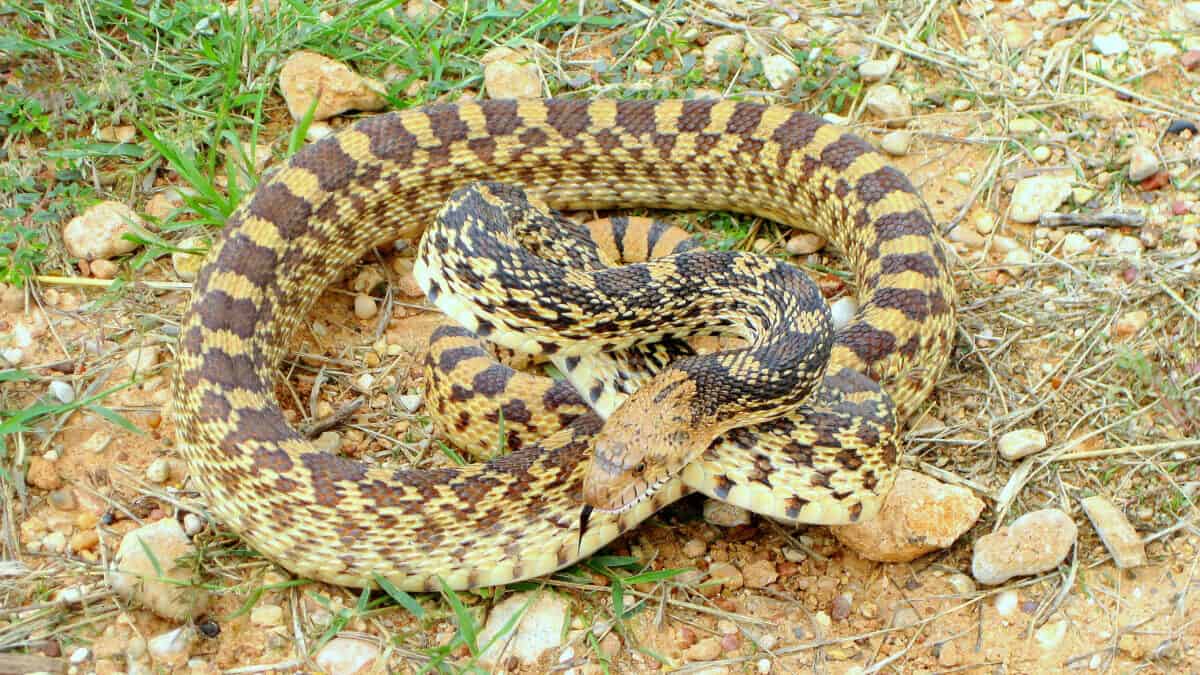
There are so many types of snakes that it can be hard to remember which ones are venomous and not venomous. One snake that often people get wrong is the bull snake. So in this article, we will answer the question: Are bull snakes venomous or poisonous?
Bull snakes are not venomous or poisonous, but they will bite when they feel threatened. They send warnings like hissing, coiling up, and shaking their tails. When they attack, they will bite and wrap themselves around someone’s arm or leg, trying to restrict them.
The good news is that they do not have venom, so there is no need to get anti-venom on hand to fight off the effects in your body. You will still want to disinfect the wound and maybe even get a doctor to check it out. Though bull snakes are not venomous or poisonous, their bites can still become infected.
Are Bull Snakes Aggressive?
Bull snakes are not going to go out of their way to strike at you, but they are likely to attack after feeling threatened or provoked. They act more aggressively than other snakes, so always proceed with caution. Never try to pick up or handle a wild bull snake. Again bull snakes are non-venomous but that does not mean they can’t cause you harm.
Bull snakes can get pretty big, ranging from 3-5 feet in length. So, they will have quite a lot of muscle on them, and they might look intimidating. That said, they will not go out of their way to harm you. So just be careful if you come into contact with a bull snake.
Are Bull Snakes Dangerous?
Bull snakes do have different ways of attacking than other snakes, but their lack of venom makes them less worrisome to deal with. But, because of their size, it is worrisome if they were to strike at a small pet or child.
It would still be unlikely that they are something you need to worry too much about but there are some things you can do to help snake-proof your yard.
You can set up snake fencing to block and prevent snakes from entering your yard. That way, you can have more peace of mind when you, kids, pets, or anyone goes into the backyard. Snakes like to be in the shade when it is warm, and in the sun when it is cold.
So in the summer, it is harder to see snakes and if you let your dog outside to run, play, and use the bathroom then they might encounter a snake. Snake fencing is not super expensive and it works great for preventative measures. It might also be smart to help seal up chicken coops or rabbit pins if you raise these types of animals.
Why Are Bull Snakes Mistaken for Venomous Snakes?
The color of bull snakes, the pattern, and the way they interact and engage with others look very similar to other venomous snakes. They will shake their tail when threatened to let you know they are getting ready to attack, and it looks very similar to a rattlesnake.
And, everybody knows that rattlesnakes should always be avoided. So it makes sense that these two snakes get mixed up. But, one key difference is that the rattlesnake makes a rattle noise, while a bull snake does not.
Bull snakes have a yellow bottom and dark splotches on their back, creating a pattern. Venomous snakes such as the rattlesnakes and copperheads also have much more triangular heads.
Another name for the bull snake is the gopher snake. If you think about a gopher, then you will think about a small animal that likes to hide in holes. This is true for the bull snake. It prefers to sit in the shade and be in a small hole or cave-like place. Female bull snakes like caves/crevices because it is a safe place to lay eggs, and they can either leave or easily protect the eggs there.
How to Avoid Getting Bitten by a Venomous Snake?
Snakes want to avoid humans as much as we want to avoid them. They don’t see us as prey but as threats. Because of that, the best way to avoid a bite from a snake is to actively avoid the snake yourself.
When you’re out on a hike, wear thick hiking boots, stick to the established trails, and, most importantly, watch where you’re putting your feet. Thick boots will protect you from the worst of a bite aimed at your foot, which would probably be one of the worst places to get bitten on a hike where you might need to use your foot to get out and get help.
Sticking to clear, established trails will help you be able to easily spot any snakes in your path. Snakes are often very easy to miss among leaves, sticks, and other forest litter. They may also hide under logs or rocks for shade. Snakes often might be coiled up in a tree or a bush as well.
Above all, watch where you’re going. The best way to avoid a snake bite is to see the snake before it’s a problem, and then carefully walk a different way. Once you know where the snake is, you should be able to pretty easily find a different path that won’t disturb it. If that’s not an option, you could also just back up and wait until it moves on.
If venomous snakes are common where you live, whether they frequent your backyard or your favorite outdoor spots, the same sort of things apply: stay alert and keep an eye out. When you spot a snake, give it a respectful amount of distance. It won’t bite you if you don’t make it feel threatened.
